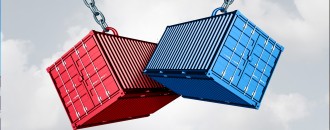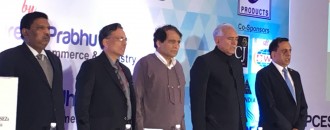
This week’s trade overview: India’s auto industry looks up, Global freight rates decline, India’s crude and natural gas prodn fall below target
By Abin Daya
A very contentious regulation came out last week in the form of the new Prevention of Cruelty to Animals (Regulation of Livestock Markets) Rules, thereby making it illegal to sell cattle for slaughter in animal markets.
While the actual impact of the regulation will depend on the implementation, which is mostly a state subject, there are fears that this will impact the $12Bn leather market and the approximately $4Bn carabeef (buffalo meat) export business. Added to this are unanswered questions of what farmers will now do with their old draught and milch cattle.
Things are already not so great for India’s leather export business, which has declined over the past 3 years.
Global trade sentiment remains weak, and indicative of this are the freight rates, which continue to fall on the back of oversupply and subdued demand. The extension of production cuts by OPEC and Russia for another 9 months doesn’t seem to have supported markets much and crude prices have fallen after the announcement. Freight rates, particularly for tankers, have fallen along with the same, and we try to understand this a little better this week.
While on the subject of oil, India’s crude processing has grown in FY16, while production has declined marginally. This can only mean that we have been using more imported crude. It would be a good exercise to chart the change in proportion of imported vs. domestic crude that our refiners use.
The growth in production and usage of petro products is also borne by the growth in automobile numbers. Production and sales have grown in FY17 at a faster pace than last year’s growth, with key drivers being two-wheelers and passenger vehicles. Commercial Vehicles sales, an important indicator of industrial activity, has grown, but at a significantly reduced pace than last year.
Before I move on to the updates, FX reserves increased by $4.04 bn in the week ending 19 May, the single largest increase in absolute or percentage terms since May 27, 2017 from when I have been tracking it. It looks like we will see Rs.64-65 levels of US $ for some more time.
Disclaimer: This is my personal opinion and I am in no way qualified to give advice on FX strategies. Please do not use this to base your hedging strategies.
Freight rates continue to fall
- The global downturn in international trade has had its negative impact on the shipping and logistics business, which has seen excess supply put pressure on freight rates
- Slowdown in China’s growth, and fall in demand in Europe and the US have adversely affected the business environment
- Reuters estimates that freight rates for Very Large Crude Carriers (VLCC), which fell to five-month lows in early May, could drop further due to excess tonnage, and reduced demand
- The off-shore storage situation for crude has improved somewhat, which has reactivated a number of old vessels which were used for the same
- Combined with new vessel deliveries, this is creating an oversupply situation in tonnage available
- About 6.9 mn Dead Weight Tonnes (DWT) from 30 new tankers was added in Jan and Feb this year, while about 12 mn barrels held in floating storage was released to refineries, bringing these tankers back to the market
- There are still about 40 supertankers currently anchored around Singapore, and used for off-shore crude storage
- At the same time, OPEC/non-OPEC output cuts and scheduled refinery maintenance have negatively impacted demand for tonnage, thus putting rates on a negative trajectory
- VLCC are also facing stiff competition from smaller Suezmax carriers, with cheaper Suezmax rates prompting charterers to split VLCC cargoes
- Rates for a Suezmax tanker with a capacity of 1 mn barrels of oil is around $15,000 per day, while rates per day for a VLCC – with capacities of 2 mn barrels – is around $44,000 per day
- However, it is unlikely that any of the VLCC owners are able to command that kind of pricing in today’s market, while they incur operating costs of around $7,500-$8000 per day (for a 300,000 DWT VLCC)
- These sentiments have also found an echo in the domestic market, where stocks of most shipping companies, including Shipping Corporation of India, Essar Shipping and Great Eastern Shipping have been falling since April
Crude and natural gas production fall below target in FY17
- India’s production of crude oil and natural gas fell below their yearly targets for FY 2017
- In fact, production of both the commodities failed to hit the previous year’s numbers, registering a decline during the financial year

- Crude production declined 2.5% in FY17 to 36 mn tonnes (MT), achieving 97.1% of the production targets for the year
- FY18 has got off to a better start in April, with production hitting 2.9MT, as against a target for the month of 3.0 mn tonnes
- Natural Gas production for FY17 declined by 1.1% to 31.9MT, to achieve just 93.5% of the annual targets
- April production of natural gas has registered a growth of 1.6% over same time in the previous year, touching 2.5 mn tonnes, lesser than the monthly target of 2.8Mn tonnes
- The April production numbers will reflect in the core sector performance for the month, which is expected to come out towards the end of May
- Volumes of crude processed, and production of distillates registered a healthy growth in FY17, though the trend has not continued for Apr 2017

- Against a target to process 240.4 mn tonnes of crude, refiners and fractioners processed 245.4 million tonnes of crude in FY17, a growth of 5.4% over previous year
- For the month of Apr 2017, however, crude processing volumes were marginally lesser than that of same month in the previous year at 20 mn tonnes; target volumes for the month were met, though
- Production of petro distillates by refineries also registered a healthy increase over previous year, and also over-achieved annual target volumes
- A total of 243.3 mn tonnes of refinery products were manufactured in FY17, against a target of 238.1 mn tonnes – a growth of 5% over previous year
- Targets for Apr 2017 are pretty modest, being at almost the same level as for Apr 2016, and this has been achieved at 19.6 mn tonnes
Auto might drive private capital investment
- The automobile sector has had a decent year in FY17 despite the impact of demonetisation which negatively affected production and sales in the months of Nov and Dec, particularly for two-wheelers
- Against 24Mn vehicles manufactured in FY16, automobile manufacturers in all segments put together manufactured 25.31Mn vehicles, a growth of 5.4%
- This compares against a weak 2.8% growth in production achieved in FY16
- Sales growth was even stronger at 6.8% to sell 21.86 mn vehicles, against 20.47 mn vehicles sold in FY16

- Two-wheelers, which comprise 80% of the market by volumes, and hence are considered as an important indicator of the overall sector health, performed better than the overall segment
- Sales growth for two wheelers was at 6.9%, while the production growth was at 5.8% compared to the previous year
- FY16 had proved to be a dismal year for two-wheelers with production growth of just 1.8% and sales growth of 3%
- Part of the reason for the lacklustre production growth in FY16 was also the performance in FY15, when production grew at a faster pace than sales growth

- The oversupply situation coming out of it could have contributed to the subdued growth in FY16
- The strongest growth amongst all segments was demonstrated by Passenger Vehicles in FY17
- PVs production grew at 9.4% and domestic sales grew at 9.2% y-o-y compared to the previous year growth at 7.6% and 7.2% respectively
- New launches and upgrades kept the market buzzing throughout the year, and even demonetisation resulted in a negative growth only during Dec 2016

- The production and sales growth of Passenger Vehicles in FY17 were the strongest in the past 5 years
- The healthy growth in domestic sales numbers and expectation of another strong growth year in FY18 has prompted many auto manufacturers to embark on their expansion plans
- While two-wheeler manufacturer Honda Motors has earmarked a budget of Rs.1,600 cr for a new 6-lakh unit production line to commence operations by July, market leader Hero has lined up capex plans of Rs.2,500 cr
- These provide the much needed private capital investments, apart from the government spending on capital expansion through infrastructure

Abin Daya the author of 'Basics of Trade: An India Perspective' is a FEMA expert, a career transaction banker, with close to 15 years of experience in corporate and transaction banking, in India.
.jpg)






 to success.
to success.